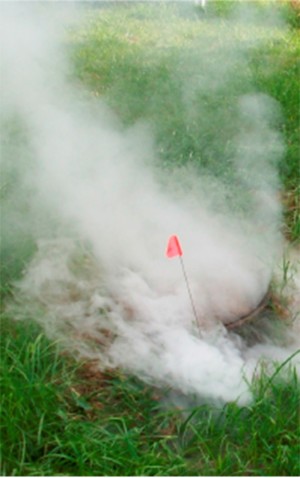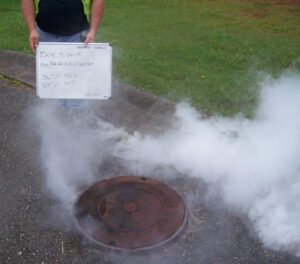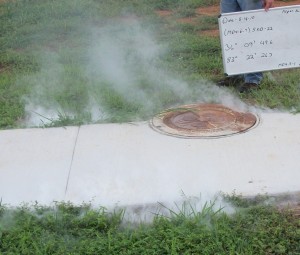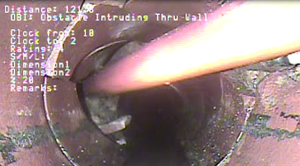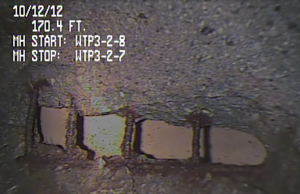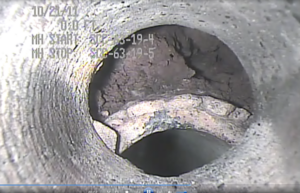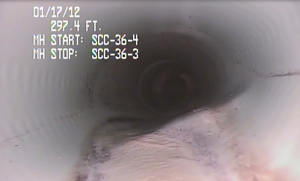By David Marcum, PE
As a work plan is developed to evaluate the gravity sanitary sewer system, all of the infrastructure (assets) must be inventoried. A typical inventory would include the gravity sewer pipe sizes, lengths, materials and age. The collection system would be divided into sewer sheds and mini-systems, which are defined below.
- Sewer shed: The drainage area defined by a natural or artificial boundary in which sources of sewerage flow reach a common collection point.
- Mini System: Individual sewer collection systems which flow within a sewer shed.
Normally, excess water that flows into sewer pipes from groundwater and stormwater is called infiltration and inflow or I/I. Excessive I/I can lead to overflows within a Sanitary Sewer Collection Systems due to the extraneous water overloading the pipe. The definition of Inflow and Infiltration are as follows:
- Infiltration: Groundwater that seeps into sewer pipes through holes, cracks, joint failures, and faulty connections at sewer laterals and/or manholes.
- Inflow: Stormwater that rapidly flows into sewers via roof drain downspouts, foundation drains, storm drain cross-connections, and holes in manhole covers.
As sanitary sewer systems are designed to carry wastewater from toilets, dishwashers, sinks, and showers in homes or businesses. Inflow/Infiltration (I/I) adds clear water to sewer systems increasing the load on the systems. Most I/I is caused by aging infrastructure that needs maintenance or replacement.
There is an abundance of data relative to flows and overflows within a City collection system. As part of the evaluation phase, at least five years of the utility’s Historical Flow/Overflow Data should be reviewed.
If the utility has already developed a Sewer Overflow Response Plan (SORP) which addresses overflows, the data collected for that document and more recent data should be used in the review. The Sanitary Sewer Overflow’s (SSO’s) will have at least the following:
- Location
- Cause
- Volume
- Rainfall
In addition to the SSO data, five years of treatment plant operating reports should be collected and reviewed.
Investigative activities could include Manhole Inspections, Smoke Testing, Closed Circuit Television, Dye Testing and Flow Monitoring. The physical inspections of the sewer system are described below.
A. MANHOLE INSPECTION
A thorough inspection of all manholes is performed and recommendations made for further action needed including manhole rehabilitation, repairs, or replacement. The results of the inspection typically include the following:
- Pictures of inside and outside of manhole
- Date and time of inspection
- Weather conditions
- Sub Basin number
- GPS-Latitude/Longitude location
- Depth of flow in pipes
- Manhole number
- Manhole depth
- Top and invert (bottom) elevation
- Manhole diameter
- Type of manhole cover
- Diameter of cover
- Manhole materials of construction
- Recommendations for repairs
- Physical condition of manhole components
- Pipe size and material
B. SMOKE TESTING:
After the manholes are inspected, the manholes and collection lines can be smoke tested. Smoke testing is one of the most efficient and cost effective methods of locating sources of inflow and infiltration (I/I). The smoke will follow the path of least resistance and quickly shows up at sites that allow Inflow and Infiltration (I/I) into the collection system. Smoke will identify broken manholes, illegal connections including roof drains, sump pumps, yard drains, uncapped lines, cracked mains and laterals.
Information that is included in a smoke testing report:
- Location of all smoke sightings
- Photographs
- Addresses of sightings
- Mini system number
- Map of the mini system with location of smoke sightings
C. CLOSED CIRCUIT TELEVISION (CCTV) INSPECTION:
Closed circuit television (CCTV) inspection is to visually inspect the internal conditions of pipes and sub-surface structures. CCTV is used basically for the following reasons:
- Scheduled inspections of the wastewater collection lines
- Documentation of sewer network topography and connections; Generation of high-quality data for development of long-term wastewater management plans.
- Emergency situations to determine the cause of stoppages, overflows, or other problems within the collection system
- Effective focusing of capital resources on sewer repair, replacement, and rehabilitation.
The following are examples of images that might be seen during the CCTV activities of the gravity sewer line:
D. DYE TESTING/FLOODING:
Dye testing is a method used to locate rain or ground water entry points into the sanitary sewer system. A dye test can be performed on any dwelling connected to the sanitary sewer system. During this process, non-toxic dyed water is introduced into roof drain leaders, driveway drains, or area drains. In some instances, dyed water is injected into the ground around foundations to check for the illegal connection of foundation drains. After introducing the dyed water, the downstream sanitary sewer manhole is checked, or if a clean out /inspection port is present, it is checked for dyed water. Dye testing with a non-toxic dye is one way of determining where a pipe or structure drains, if it is not obvious by observation or on existing plans or records. By conducting dye testing, inappropriate connections can be identified.
E. FLOW MONITORING:
Monitoring flow at key manholes along the main interceptor and key manholes which represent flows from the sewer sheds/mini-systems is an important part of a sewer system evaluation. Collecting the data and measuring the flow is important to determine the amount of incoming wastewater, including inflow/Infiltration (I/I) at various stages of the sewer collection system. In conjunction with the flow monitoring, rain gauges are installed within the various sewer sheds/mini-systems as deemed necessary to determine the correlation between rainfall and sewer flow.
The primary and initial areas of concern are those referred to as critical mini-systems. However, as a hydraulic model of the wastewater collection system is developed, other critical areas may be identified.
“Critical Mini-Systems” are defined as those mini-systems that:
- have experienced sanitary sewer overflows within the past five years
- are upstream of areas experiencing sanitary sewer overflows or pipe capacity issues.
Critical Mini-Systems are primarily created by excessive inflow and infiltration from heavy rainfall events. This evaluation process is critical to developing a plan for removal of I/I, and can also be utilized to analyze the impact of future development.

